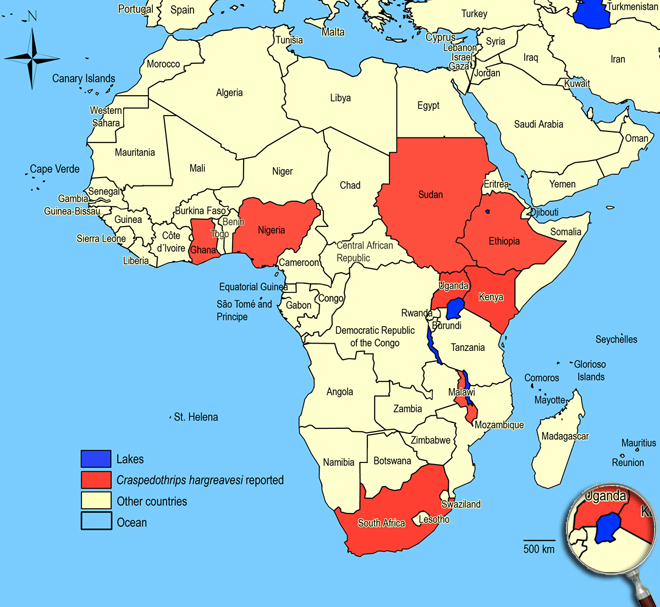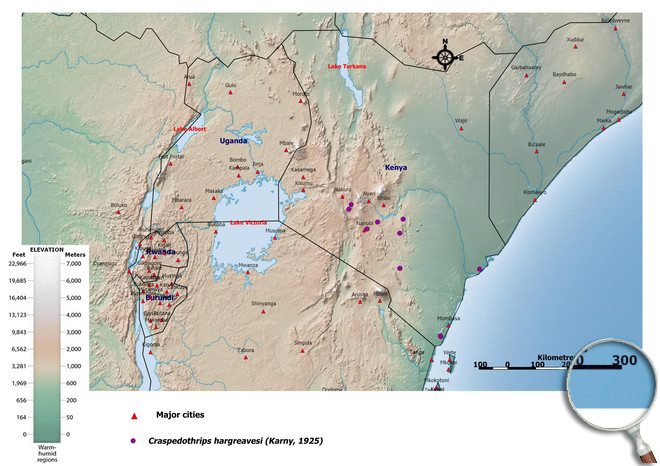Craspedothrips hargreavesi (Karny, 1925)
Thripinae, Thripidae, Terebrantia, Thysanoptera
Figures
Fig. 1: 8-segmented antenna, terminal segments V-VIII, segments III and IV with forked sense cone (female)
Fig. 2: 8-segmented antenna, segments IV-VI with numerous long setae (male)
Fig. 3: Head dorsal with ocellar triangle
Fig. 4: Pronotum
Fig. 5: Meso- and metanotum
Fig. 6: Meso- and metasternum
Fig. 7: Fore wing, fore wing distal region
Fig. 8: Tergites VII and VIII
Fig. 9: Sternite VII and ovipositor
Fig. 10: Tergites IX-XI
Introduction and recognition
Craspedothrips hargreavesi causes damage to flowers of various plant species like beans, cotton and yam. Female macropterous; body brown; fore tibia and all tarsi yellow; antennal segment II paler at apex, III yellow, IV and V yellow at base; fore wings greyish brown with a paler area at base. Antennae 8-segmented; segments III & IV with forked sense cone, I with pair of small dorso-apical setae, VI bears the stout dagger-shaped sensorium on the external margin (Fig. 1 and 2). Head wider than long and prolonged in front of compound eyes; with 3 pairs of ocellar setae, pair III arising on tangent across the anterior margin of, or between hind ocelli (Fig. 3). Pronotum rectangular; with 2 pairs of elongate posteroangular setae (Fig. 4). Mesofurca with median spinula (Fig. 6). Metanotum median area with weakly transverse reticulations at anterior and irregular longitudinal or equiangular reticulation on posterior half; median pair of setae longer than lateral pair and arising at margin; campaniform sensilla present (Fig. 5). Mid and hind tarsi 2-segmented. Fore wing first vein with 2 or 3 setae on distal third; second vein with a complete row of 9-12 setae (Fig. 7). Tergites IV-VIII with posteromarginal complete craspedum of unbroken border or flange (Fig. 8). Sternites without discal setae but with posteromarginal craspedum of broken border by 3 pairs of posteromarginal setae; sternite VII with median pair of setae in front of posterior margin (Fig. 9).
Male rare, with greatly enlarged and heavily setose antennal segments IV-VI; sternites without glandular areas.
Taxonomic identity
Species
Craspedothrips hargreavesi (Karny, 1925)
Taxonomic history
Mycterothrips fuscus Priesner, 1936
Taeniothrips crassiconus Moulton, 1930
Physothrips hargreavesi Karny, 1925
Common name
-
Present taxonomic position
Family: Thripidae Stephens, 1829
Subfamily: Thripinae (Stephens) Karny, 1921
Genus: Craspedothrips zur Strassen, 1966
Genus description
The genus Craspedothrips zur Strassen, 1966
8 species from the Old World tropics are listed in this genus. Members characterised by antennal segments III & IV broad and distinctly constricted distally, antennal segments V and VI have a stout dagger-shaped sensorium on the external margin, and a long mouth cone. Tergite VIII without posteromarginal comb and sternites without discal setae. A tergal and sternal craspedum as indicated by the genus name (Bhatti 1995) is not always present, and as in Trichromothrips genus-group (Masumoto & Okajima 2005) the first antennal segment bears a pair of dorso-apical setae.
Species description
Typical key character states of
Craspedothrips hargeavesi
Coloration and body sculpture
Body color: mainly brown to dark brown
Surface of head, pronotum and fore legs: without obvious or with weakly reticulate sculpture
Antennae
Form of sense cones on antennal segments III and IV: emergent and forked on segments III and IV
Number of antennal segments: 8
Antennal segment I: with pair of small setae on dorso-apical margin
Antennal segment II: without an exceptionally long seta at the inner apex
Antennal segment II shape: symmetric
Antennal segment III shape: symmetric
Length of antennal segment III and IV: antennal segment III similar in length to segment IV
Antennal segment IV: not distinctly elongated and fusiform
Antennal segment IV and V: without a hyaline ring at the base
Forked sense cone on antennal segment IV: scarcely extending beyond base of segment V
Antennal segment VI bears: a stout dagger-shaped sensorium on the external margin
Head
Distance between bases of ocellar setae III: same or less than width of first ocellus
Head: distinctly prolonged in front of compound eyes
Ocellar setae I: present
Length of ocellar setae II: shorter than setae III
Ocellar setae III: arising on tangent across the anterior margin of, or between hind ocelli
Ocelli: present
Length of postocular setae: not alternating short and long setae
Number of ocellar setae: 3
Prothorax
Number of pairs of long anteroangular setae: 0
Number of pairs of long posteroangular setae: 2
Number of pairs of elongate pronotal setae: 2
Number of pairs of posteromarginal minor setae: 3
Pronotal blotch or internal apodeme: absent
Pronotum shape: broadly rectangular
Pronotum posteromarginal/posteroangular setae: S2 longer than S3, not equal in length
Mesothorax
Mesosternal furca: with median spinula
Metathorax
Metanotal campaniform sensilla: present
Metanotal median setae: S1 at anterior margin
Metanotum with dominant sculptured triangle medially: absent
Metasternal furca: without spinula
Sculpture of metanotum median area: transverse at anterior, but irregular longitudinal or equiangular reticulations on posterior half
Shape of metathoracic furca: transverse, V-shaped
Metanotal median setae length: longer than lateral metanotal setae
Wings
Fore and hind wings: present, more than half as long as abdomen (macropterous)
Fringe cilia arising: from sockets
Fore wing veins: present
Fore- and hind wing surface: covered with microtrichia
Apex of fore wing: with prominent terminal setae
Fore wing anterior margin (costal vein): with setae and cilia but cilia longer than setae
Fore wing costal fringe cilia: arising at anterior margin of wing
Fore wing first vein: distinct from costal vein
Fore wing first vein setal row: incomplete, with setae not closely and uniformly spaced
Fore wing number of setae of second vein: 9-12
Fore wing second vein setal row: complete, setae uniformly spaced
Fore wing shape: mainly parallel sided or margins run continuously towards each other
Fore wing surface: not reticulate
Fore wing first vein number of setae on distal half: 2-3
Fringe cilia on posterior margin near apex: distinctly wavy (undulated)
Length of fore wing costal setae at middle of wing: longer (rare shorter) than half of median wing width
Shape of fore wing apex: with mainly posterior margin curved to join anterior margin
Fore wings: uniformly dark or shaded, but with base or sub-base pale
Fore wing extrem apex color: dark (rare: pale)
Legs
Fore tibia: not prolonged around fore tarsus
Mid and hind tarsi: with two segments
Color of fore tarsi: pale or yellow, sometimes apically shaded or brown
Abdomen
Pleurotergites: not covered in microtrichia
Sternite II: with marginal setae but no discal setae
Craspedum on sternites II to V: present, craspedum of broken border by 3 pairs of posteromarginal setae
Sternites IV, V and VI: with marginal setae but no discal setae
Sternite VII median posteromarginal setae S1: arising in front of posterior margin
Sternite VII: with marginal setae but no discal setae
Surface of lateral thirds of abdominal tergites: without regular rows of fine microtrichia
Tergites II to VII median setal pair: no more than 0.3 as long as median length of tergite
Craspedum on tergites IV to VI: present, continuous craspedum
Tergites IV and V median setal pair: shorter than distance between their bases
Tergites V to VII: without ctenidia laterally, but sometimes with rows of microtrichia
Craspedum on tergite VIII: with continuous craspedum
Tergite VIII ctenidia: without paired ctenidia laterally, sometimes with irregular microtrichia
Tergite VIII posteromarginal comb of microtrichia: absent
Tergite X: not tubular, longitudinally incomplete
Setae on abdominal tergite X: all setae slender

Similar or related species
Compared to Craspedothrips hargreavesi, the similar species Craspedothrips xanthocerus has an antennal segment IV that is distinctly elongated and fusiform, antennal segments III-VIII all with a light yellow color, ocellar setae I in front of anterior ocellus absent or indistinctly, metanotal median area without sculptured lines or only scarcely sculptured, the second vein of fore wing with 16-17 setae, and tergites and sternites without any craspedum. Whereas Craspedothrips hargreavesi possesses an antennal segment IV that is not distinctly elongated and fusiform, antennal segment III is yellow, IV and V yellow at base, and VI-VIII completely brown, ocellar setae I in front of anterior ocellus is present and distinct, the metanotal median area has weakly transverse reticulations at anterior and irregular longitudinal or equiangular reticulations on posterior half, and the second vein of fore wing has only 9-12 setae. Moreover, in Craspedothrips hargreavesi tergites have a complete craspedum of unbroken border or flange, and sternites a craspedum of broken border by 3 pairs of posteromarginal setae.
Species of Craspedothrips are similar to Chirothrips guillarmodi, Diarthrothrips coffeae, and Scolothrips rhagebianus in having 8-segmented antennae with forked sense cone on segments III and IV, tergite VIII without paired ctenidia and without regular rows of fine microtrichia laterally, and without posteromarginal comb of microtrichia, and in having 2 pairs of elongate pronotal posteroangular setae. But Chirothrips guillarmodi has a trapezoidal pronotum and a mesosternal furca without median spinula, Diarthrothrips coffeae with a metasternal furca with median spinula and tergites with median pair of setae longer than distance between their bases, and Scolothrips rhagebianus has a metasternal furca with median spinula and altogether 6 pairs of elongate pronotal setae.
Biology
Life history
As with other thrips species the life cycle from egg to adult is dependent on temperature. The full cycle can take less than a week to over a month and adults may live for more than one month producing several generations in one year depending on seasonal weather (Lewis 1973).
Host plants
Frequently associated with Aloe vera, on flowers of various plant species.
Crops: beans, Bixa, cashew, carrot, cassava, cowpea, cotton, mango, yam.
Weeds: Glycine wightii, Senna occidentalis.
Vector capacity
None identified, but possible mechanical distribution of phytopathogenic fungi and bacteria.
Damage and symptoms
-
Detection and control strategies
-
Additional notes
-
Biogeography
Afrotropical Region, Yemen. Ethiopia (Ever Gota),
Ghana (Yegi),
Malawi (Lilongwe),
Nigeria (Ibadan),
South Africa (KwaZulu-Natal: Richarďs Bay),
Sudan (Tayiba - Blue Nil Province),
Uganda (Kampala).
African countries where Craspedothrips hargreavesi has been reported

Occurence of Craspedothrips hargreavesi in East Africa

Please click here for survey sites of all observed thrips species of Kenya, Tanzania and Uganda.
Click here for locations of Craspedothrips hargreavesi in parts of East Africa.

Bibliography
Bhatti JS (1995). Further studies on Taeniothrips sensu lato (Insecta: Terebrantia: Thripidae). Zoology (Journal of Pure and Applied Zoology). 5 (1): 73-95
Karny H (1925). On some tropical Thysanoptera. Bulletin of Entomological Research. 16 (2): 125-142
Lewis T (1973). Thrips: their biology, ecology and economic importance. Academic Press Inc., London Ltd., 349 pp
Masumoto M & Okajima S (2005). Trichromothrips Priesner (Thysanoptera, Thripidae) of Japan and Taiwan, with descriptions of four new species and a review of the Trichromothrips group of genera. Zootaxa. 1082: 1-27
Moritz G (2006). Thripse. Pflanzensaftsaugende Insekten, Bd. 1, (1. Auflage). Westarp, Hohenwarsleben, 384 pp. ISBN-13: 978 3 89432 891 7
Moritz G, Morris DC & Mound LA (2001). ThripsID - Pest thrips of the world. ACIAR and CSIRO Publishing Collingwood, Victoria, Australia, CDROM ISBN 1 86320 296 X
Moulton D (1930). Thysanoptera from Africa. Annals and Magazine of Natural History, Zoology, Botany and Geology. (Serie 10) 5: 194-207
Pitkin BR & Mound LA (1973). A catalogue of West African Thysanoptera. Bulletin de ľInstitut Fondamental ďAfrique Noire, Série A. 35 (2): 407-449
Priesner H (1936). On some further new Thysanoptera from the Sudan. Bulletin de la Société Royale Entomologique ďÉgypte. 20: 83-104
Priesner H (1964). A monograph of the Thysanoptera of the Egyptian deserts. Publications de ľInstitut du Desert d´Égypte (1960). 13: 1-549
zur Strassen R (1966). Craspedothrips, eine neue aethiopische Thripiden-Gattung (Ins., Thysanoptera). Senckenbergiana Biologica. 47 (6): 443-446
----
Web links
Mound´s Thysanoptera pages
Thysanoptera Checklist
ICIPE Thrips survey sites
UNI Halle & Thrips sites
Thrips of California














